By the turn of the century, the flowerhorn cichlid had become one of the most popular species in the ornamental fish trade.

In addition to its size and vibrant colors, the flowerhorn is a very personable fish that’s extremely fun to keep.
But that’s not all, these fish have so much more up their sleeves!
In today’s article, we discuss in detail why and how these fishes rose to fame and also how to care for them.
At a glance
| Min tank size: | 70 gal (265 l) |
| Temperature: | 80 to 86°F (26.6-30°C) |
| Lifespan: | up to 12 years |
| Behavior: | aggressive and territorial |
| Size: | 12 to 16″ (30-40 cm) |
| pH: | 7.0-8.0 |
| Hardness: | 8 to 20 dGH |
In this article
Origins
Interestingly, the flowerhorn is a man-made fish. It was created by the hybridization of two different South American cichlids.
While the exact combination which produced the first flowerhorn is unknown, it has evolved tremendously, and many different variations are now available on the market.
Originally developed in Malaysia, the flowerhorn was touted as a positive feng shui influence for the areas in which it was kept. It was also a symbol of wealth.
These factors made it especially popular with the Chinese population in the region.
The widespread popularity further increased in the nearby areas as these fishes were believed to display winning lottery numbers on their bodies.
This drastically inflated prices, with some fishes going for several thousand dollars!
One of the most noticeable features of the flowerhorn is the huge hump on its head. Although only present in males, this gelatinous hump gave the flowerhorn its unique name.
Appearance

The flowerhorn is a medium-sized fish, growing up to about 15 inches or 38 cm (depending on the variety – some grow slightly larger).
Males will generally display brighter colors, more vivid patterns and will also grow a distinctive head hump. Males also grow about an inch or two larger than their female counterparts.
Selective breeding has since increased the size of the humps in some variations.
A Chinese belief holds that the larger the hump, the more wealth and prosperity will be ushered into the area. Thus the fish have been bred specifically for bigger head humps.
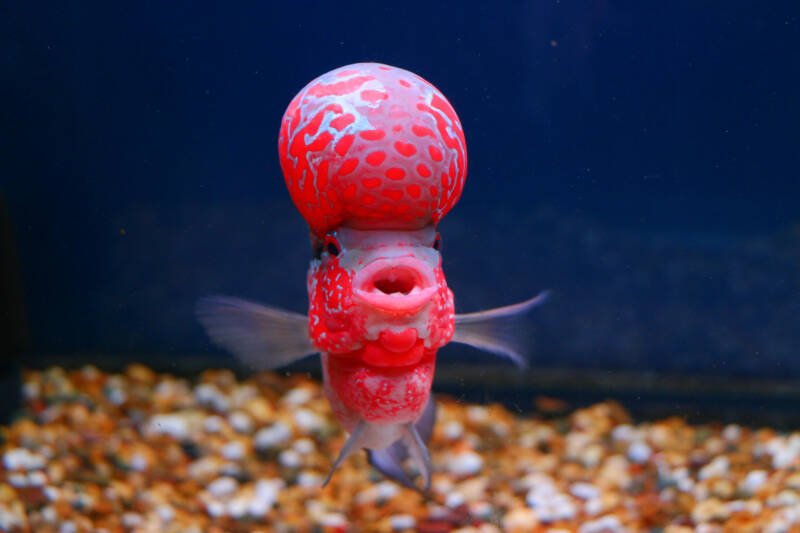
Other than its hump, one of the most iconic features of the fish is its fins. The tail is generally round, shaped like a fan, and framed by long, graceful dorsal and anal fins.
The coloration of flowerhorns also varies quite a bit. Generally bright, the first flowerhorns had colors that closely resembled a jack dempsey.
Since then, they’ve been bred to come in all sorts of colors. Whether you’re looking for a solid gold-colored fish or a mix of pink and greys, there’s definitely one for you.
Behavior
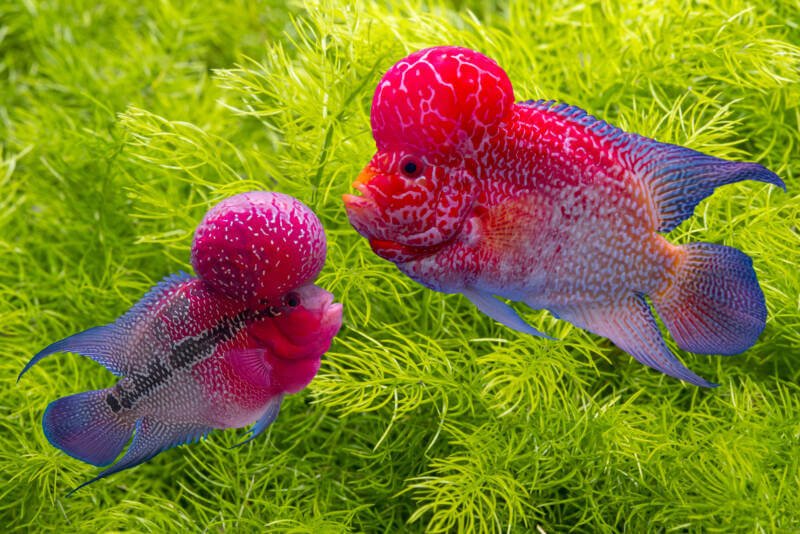
Most flowerhorns are very personable. Many keepers have described the experience as ‘keeping a dog in a fish tank.’
The flowerhorn, like most cichlids, are territorial and aggressive. While they can get along with some fishes, it is more common to see them in species-only tanks.
Due to their aggressive nature, keeping multiple mature flowerhorns will pose problems as they will fight with one another.
Most keepers opt to keep them either in sexed pairs or solo. You will notice that even in the local fish stores, they are often kept separate from other flowerhorns.
Sexually paired flowerhorns breed readily and are a joy to keep as they often will swim together around the tank.
Due to their prolificacy and hardiness, these fish have even become pests in some parts of the world due to owners dumping them in reservoirs and such.
Flowerhorn Diet
The flowerhorn is an omnivorous fish with a voracious appetite. Most of its diet consists of protein-rich foods such as bloodworms, shrimp, and other fish.
Suffice it to say, you should not keep smaller fish with flowerhorns as they will either get eaten or at least suffer extreme stress.
Commercially available pellet foods are also suitable since flowerhorns are not picky eaters.
We recommend supplementing their diet with wet food such as worms or chopped shrimp to vary their diet.
While most common digestive afflictions do not affect them as much as they do other fishes, flowerhorns occasionally do come down with something.
One of the more common problems is bloating, so we recommend feeding them some form of wet food every now and then to stimulate their digestive systems.
Water Parameters

Flowerhorns are a hardy species of fish. Even with many line-breeding generations, these fish still grow without any problems and can survive well in most water conditions.
Although there isn’t much of a blueprint for what’s best for them since they’re man-made fish, most of their ancestors originated from hot tropical waters.
We’ve had great success with temperatures in the 72°F to 86°F (22-30°C) range and a pH value between 7.5 and 8.0.
This species, however, seems to be more sensitive to ammonia than most. Hence it would be best only to introduce them into a tank after it has been well cycled.
Like we mentioned earlier, most keepers opt to keep the flowerhorn in a species-only tank with little or no decor.
This is because the flowerhorn is an inquisitive fish and tends to uproot most plants and push objects around the tank.
Flowerhorn Tank Setup
As for tank sizes, due to their relatively large size once full-grown, it is recommended that you keep flowerhorns in tanks of no less than 30 gallons.
Breeding pairs will require a larger tank of at least 150 gallons.
That said, another important reason these fish require larger tanks is due to their voracious appetites.
They produce a substantial amount of waste, and a larger water volume will help keep excess nutrients low.
A robust filtration setup is recommended for all the reasons listed above. We strongly recommend a sump system to increase both the volume of water and filter media’s surface area.
However, this might not be possible in all homes due to the large size and extra equipment needed.
We recommend a flow rate of at least ten times the tank’s volume per hour.
Higher flow rates do not easily stress this fish so if you feel the need to crank up the pump, it should be fine.
Tank Mates
Flowerhorns are generally an aggressive species that will prey on most smaller fish and bully fishes of similar size. Hence, they do not make good community fishes at all.
However, some species do quite well with the flowerhorn.
Bear in mind that their aggressiveness varies between the different varieties, so some of these options might not work and should be removed if you see serious signs of aggression.
1. Plecostomus
Plecos are one of the few species that do well with flowerhorns. They are peaceful, don’t stress easily, and generally mind their own business.
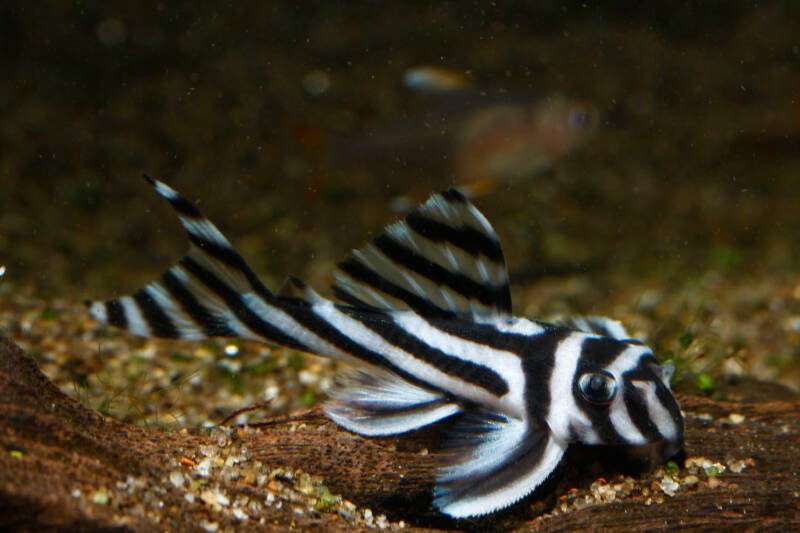
2. Oscar cichlid
Another option is the oscar cichlid. They grow to similar sizes as flowerhorns and come from the same family (though not the same genus).
The oscar is a good option because they have similar temperaments to the flowerhorn, so they’ll find ways to coexist together.
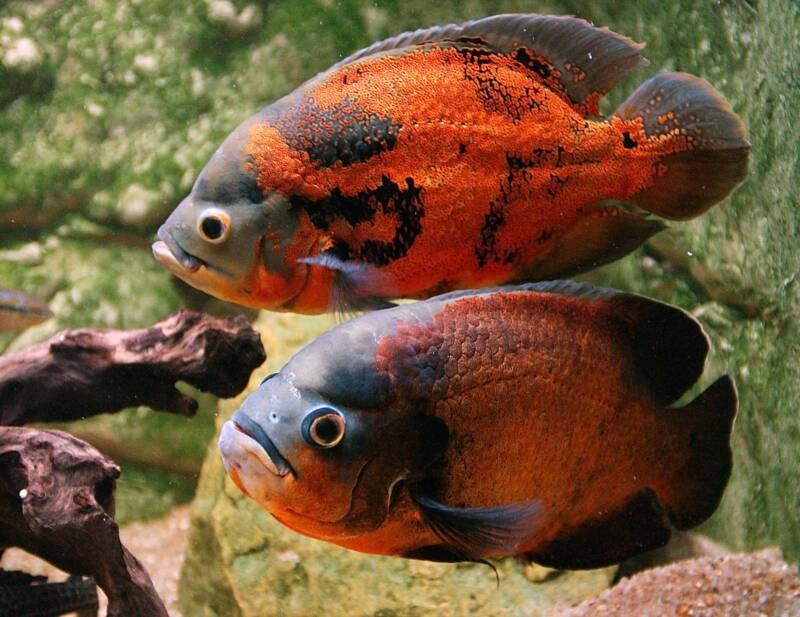
3. Arowana
One of the more popular tank mate options for hobbyists in the Asia Pacific regions is the Arowana.
Arowanas are aggressive fish with a natural tendency to spend most of their time at or near the surface.
While both fish are quite aggressive, they seem to do well together, possibly because they almost exclusively inhabit different parts of the tank.

We also have an in-depth article about tank mates for flowerhorn.
Care
Caring for flowerhorns is easy as they are not picky eaters and are hardy fishes.
Most of their care revolves around avoiding the temptation to feed them too much and just keeping up with the maintenance schedule.
This fish is, however, relatively sensitive to high levels of ammonia.
Like we mentioned earlier, it will be best to only introduce new flowerhorns into fully-cycled tanks. Introducing them any earlier runs the risk of killing them of ammonia poisoning.
We generally feed our flowerhorns two to three times a day due to their voracious appetites.
For food items, we alternate between commercial pellets and wet food, such as frozen bloodworms.
We generally don’t feed our fishes live food due to the risk of parasites, but if you are getting them from a safe source, live food is also a good way to stimulate their digestive systems.
The reason wet food is important is the flowerhorns’ occasional problems with impaction. Feeding wet food helps to reduce the likelihood of this problem.
As for maintenance, we perform weekly water changes with treated tap water, replacing an average of 20% of our total tank volume. This helps to remove excess nutrients and keep things healthy.
Common ailments
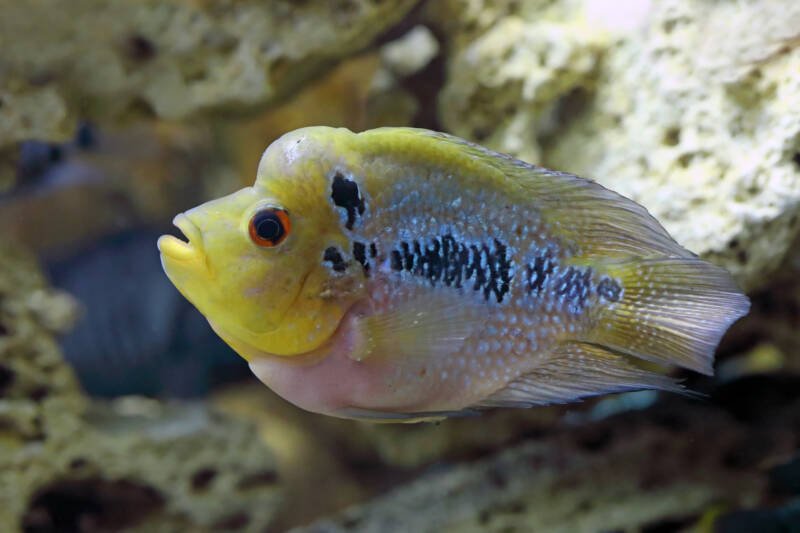
Although the flowerhorn is an exceedingly hardy fish, some common ailments can affect them.
Among the most common ailments are digestive problems such as impaction and bloating.
Of course, this is linked to their glutinous appetite. While it can be a good thing for most keepers, it is important to control the amount of food going into your fish.
A general rule of thumb we use is to feed the fish all it will eat within a three- to four-minute timeframe and also vary their diet with wet items such as worms.
As keepers ourselves, we understand the urge to feed our fish constantly, but we will be left with obese and unhealthy fish if we do not refrain.
Ich is another fairly common disease that affects the flowerhorn.
Ich is a parasite often associated with bad husbandry techniques, i.e., not changing water, overfeeding, etc. It presents itself as small white specks all over the fish.
If treated early, ich is easy to get rid of. There are plenty of over-the-counter medications on the market today, which are very effective.
One of the more serious illnesses that affect the flowerhorn is hexamita, more commonly known as ‘fish hole-in-the-head disease.’
Hexamita is a fatal disease caused by parasites that create lesions and eat away at the fish’s head.
This disease is particularly dangerous to flowerhorns due to their gelatinous ‘kok’ or head hump.
Hexamita is also usually caused by bad husbandry techniques, and like ich, can be cured easily if treated early with over-the-counter medicines.
Breeding
Breeding flowerhorns, like most cichlids, is a relatively easy task. All you will require is the right size tank with the correct parameters and mature individuals.
Flowerhorns usually mature around nine to ten months of age. A defining feature is the head hump in males and the lack thereof in females.
It is, however, important to note that a large percentage of male flowerhorns are infertile due to their status as hybrids!
Most females, on the other hand, are fertile, so only males require testing. The only way to test them is to breed them.
The mating process can be quite violent. Males will chase the female around the tank to court her.
We recommend a large enough tank – at least a 40-gallons for a single pair of fishes – as well as some rocks or a clay dish for them to lay eggs on.
You will also need a transparent divider with a hole that is only big enough for the female to go through. This will give her a chance to escape the male’s advances or aggression if she feels threatened.
Pairing
The pairing process is simple. Place both fishes in the same tank, separated in the center by the transparent divider.
Both fishes will show aggression during the first few days of courtship. This is entirely normal. The transparent divider will ensure that the female has a secure space in the tank where she will be safe.
The female’s coloration will generally brighten as she prepares to lay her eggs. Her ovipositor (egg-laying organ) will protrude out by several millimeters as well.
By this time, the male will usually tone down, but they will continue to show a little aggression. Again, this is normal. The transparent divider should also be removed.
If the aggression becomes too extreme, put the divider back into the tank and wait a few more days.
Spawning
Upon removing the divider, the female should already be ready to lay her eggs.
Egg-laying usually takes about an hour or two, and the male will swim over the eggs to fertilize them.
Each spawning will result in about 10-30 eggs at a time, and they will spawn multiple times. Once the eggs are laid, the parents usually stay to watch over their eggs until they hatch.
Spawning is a physically draining process, so it is normal to see a reduction in the male’s hump size and a reduction in color intensity. Do not be alarmed.
Once fertilized, the eggs will hatch in about three days and will require food at around the five-day mark.
Raising Fry
As you may have guessed based on the flowerhorn’s appetite, it is important to separate the adults from the babies once they hatch.
The adult fish may be a danger to the young if they get particularly hungry. In fact, even month-old flowerhorns may eat the newly-hatched fry.
By the six- or seven-day mark, the fry become free-swimming and will be searching for food.
Usually, we start them off with baby brine shrimp for the first two weeks and feed three to five times daily.
Once the fry are slightly larger, they can be switched over to daphnia three times a day.
Both frozen or live foods work fine. We tend to go with frozen daphnia as there is a lower risk for parasites.
At the one-month mark, they can be fed frozen bloodworms, tubifex worms, or brine shrimp.
There usually isn’t a problem feeding them as they have quite a big appetite. Feeding can be reduced to twice daily or the same as the adults.
At the two-month mark, they can be fed on the same foods and schedules as the adults, which is twice a day for us.
Breeding Tips
We generally turn off the filter when spawning is about to happen. This is because the eggs are fertilized externally. A strong flow will decrease the chances of a successful spawn.
Lighting should also be kept at a minimum, with dark areas in the tank, if possible. Brightly-lit tanks tend to stress both the male and the female.
As for water conditions, be sure to use treated tap water. Chlorine and other additives will surely kill the eggs. We usually use aged tap water just to be on the safe side.
Final Thoughts
Keeping flowerhorns is a rewarding experience due to the ease of care and the enjoyable personalities these fishes exhibit.
Most often, owners grow very attached to their flowerhorns because of their unique and curious personality.
We hope you’ve had as much fun reading this article as we had putting it together.
Please leave questions and comments in the section below!